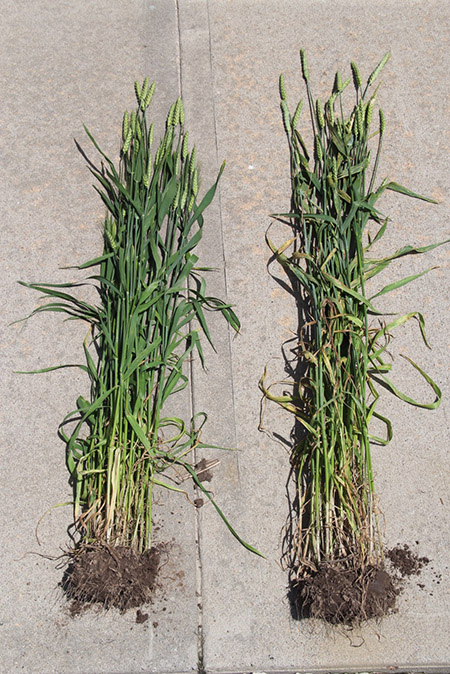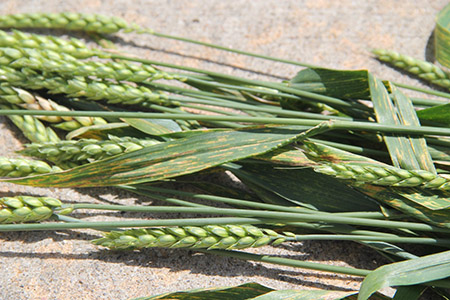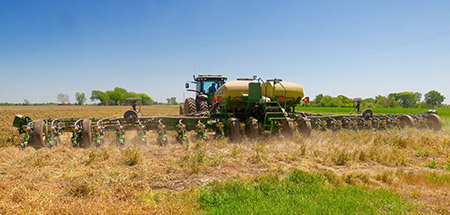This yearlong endeavor looks at how four farmers are evaluating technology and agronomic information that can boost the productivity of their operations.

The 2015 growing season has been a good teacher, and Steve Cubbage has been an attentive student.
"There's been plenty to learn this year. Now, the challenge is to take that information and plug it in for next year's crop," the Nevada, Mo., farmer says.
And, at the top of his list is nitrogen.
NITROGEN EFFICIENCY. "The whole protocol of putting all of your nitrogen down in late fall or even early spring is out the window," Cubbage explains.
This year, wet spring conditions prompted BASF Innovation Specialist Kaleb Hellwig to sample soil in–season to get a better handle on available nitrogen.
"We would have underestimated the sidedress N we needed," Cubbage says. "Based on Kaleb's testing, we applied 10 to 20 pounds per acre more than we would have, and it looks like it paid off."
Cubbage also used strip tests to evaluate nitrogen inhibitor products, as well as side–dress N rates."I think the inhibitors helped but we'll have to look at the numbers after harvest," he notes.
RETHINKING WHEAT: The 2015 growing season convinced Cubbage to drop wheat from his cropping plans. Explaining, "the numbers just aren't there right now," he reports problems with vomitoxin have also left him with wheat he cannot sell.
"We're creating a silver lining from a bad situation," Cubbage explains. "Our goal is to get a cover crop on every acre, and we're going to utilize that unsellable wheat as a cover crop to retain some value."
Dropping wheat will also provide an opportunity to repair terraces and waterways and accomplish other conservation tasks.
Wet weather delivered another lemonade–out–of–lemons opportunity. About 500 acres of intended double–crop soybean fields stayed too wet, too long. Those prevented planting acres were fallow until worked in August by a vertical tillage tool with an attached seeder delivering tillage radish seed.
"We normally aren't able to get a cover crop in that early and we got a great stand," Cubbage says. "We expect excellent tap root growth before it freezes and that's going to help break up compaction and facilitate nutrient movement in the soil."
EARLY CORN ADVANTAGE. The growing season also reinforced his belief in planting corn early.
"It's difficult, but there's a reason to push the limit on corn planting dates," says Cubbage. "Early–planted corn is, by far, our best. This year, a two– to three–week delay in planting probably cost us 30 to 40 bushels per acre. Next year I won't hesitate to go the third week of March if the soil temperature is near 50 degrees."
Although the verdict is still out, this year also piqued his interest in non–GMO corn.
"It looks good—I'd say it's on a par with our better corn, and if that holds it will be more profitable," he observes.
HERBICIDE TRANSITION. The 2015 learning–and–growing process moved Cubbage Farms further down the road to a new herbicide strategy.
"Roundup is quickly becoming a secondary product," Cubbage explains. "Pre–emergence herbicides are back, and residual action is essential. We're relying heavily on Kaleb Hellwig [BASF Innovation Specialist] to help us transition to a more effective chemical strategy."
For Cubbage and many other soybean growers, resistant waterhemp has become enemy No. 1, and that calls for deliberate action.
"The best approach for waterhemp is preventing it from coming up," Hellwig says. "No matter what system you're using, it needs to be supported by layered residual herbicide applications."
LAYERING RESIDUAL ACTION. Hellwig calls waterhemp "relentless," noting it can germinate from April through August in western Missouri. So regardless of the herbicide program used, it's going to need some help.
Ideally, Hellwig suggests farmers make an herbicide application two weeks ahead of planting. Verdict and Zidua are among his top choices at that time. He recommends following up with a postemergence treatment of Roundup along with an herbicide such as Outlook.
"We expect four to five weeks of residual action on waterhemp, so our goal is to get the second layer on just as the first product is running out," Hellwig explains. "Generally, if we can keep the beans clean eight to nine weeks the soybeans are canopied—they're off and running."
He emphasizes that while most growers fight waterhemp, they likely have other unique weed challenges. "You can't exclusively focus on waterhemp. Some products that are good for that weed aren't particularly strong on others," Hellwig says. "You have to design a combination that fits your situation."
BETTER DRONE UTILITY. On the technology side, Cubbage is excited about the farm's developing use of drone–generated, actionable aerial data.
"We're still learning but we've taken a big step forward using DroneDeploy," he says. "With their software, we download an app to an iPad and program a drone to fly a set pattern. We get a geo–referenced image in about 30 minutes.
"It's more than just pretty pictures. It's an accurate image of a given area that we can utilize for in–season assessments. We can spot shattercane early, ID pivot nozzles that need attention, locate compacted areas, make sure planter clutches are working correctly—things that you can still do something about or conditions you can address next season."
In the long run, Cubbage concludes, learning is the most important commodity a farmer can harvest.

I've been telling people lately that I feel like I'm living in the Pacific Northwest instead of the Midwest.
For nearly the past two months those of us in Missouri-especially the western half of the state-have endured weather more common to that found in Seattle than that of Kansas City. Other than a week-long window of good weather toward the end of April, we've been covered by gray skies, saturated by excess moisture and blanketed by persistently cool weather.
Such weather presents growing challenges no matter what crop you may be trying to raise. For our young corn crop it certainly looks to be a much more challenging year than last year. However, the more immediate concern during this period was our hopefully soon to be harvested 2015 winter wheat crop.
My granddad always used to have a saying when it came to planting wheat: "Plant your wheat in the dust, and your bins will bust." The point he was trying to make was that typically wheat does not like wet feet." Of course, he and my great granddad were transplants from the drylands of Colorado during the time of the Dust Bowl and the Great Depression.
Growing wheat in Missouri is whole different animal, primarily because of a thing called humidity-something that Colorado and western Kansas really don't have to deal with on a regular basis. High humidity levels provide the perfect environment for diseases to thrive. It is because of that reason that we have not had much luck in trying to grow the hard red winter wheat varieties, as their genetics seem to prefer a dryer growing season. Instead, we grow soft red winter red-you know, the stuff that is usually worth a $1 less per bushel at the grain elevator.
If managed correctly, soft red winter wheat varieties can have tremendous yield potential. This year we've had to be extra aggressive when it comes to the in-season management of wheat. We already knew in late March the weather pattern for the next month or so looked cooler and wetter than normal. So, spraying fungicide on wheat was a fairly easy call. We've tried to be proactive as a majority of our acres have been treated with the fungicide Twinline. By the looks of things, it has the potential to pay benefits many times over.

When scouting our wheat fields just last week, the visual comparisons of our untreated wheat acres verses those treated with fungicide were strikingly evident. Fusarium head blight-better known as head scab-and a cocktail of leaf diseases are common in our untreated acres. Many heads of wheat are already partially dead, and their numbers are likely to increase given the wet weather that has hung on. That is not the case in the acres treated with fungicide. It will be interesting to see the yield maps come harvest, so stay tuned for that report.
The moral of this story is fairly simple. Our wheat crop came through winter in pretty good shape, and protecting potential yield became a priority for us. Why? Right now, because of the continued downward pressure on commodity prices, it is likely that the difference between a profit and a loss on our wheat acres looks to be hinging on whether it received a fungicide treatment. Fungicide treatments may not always pay off, but they are becoming a pretty good insurance policy to protect profits.

Corn planting on our farm is nearly complete albeit three weeks later than what we would have preferred.
As we finally stop to catch our first breather of the busy spring season, we'll be keeping a close watch on our freshly planted fields. Actually it may be a misnomer to call our fields "freshly planted" because truthfully looking at most of them you can't even tell we've even been there.
The reality is that most of our corn was planted into fields still sporting their decaying winter coat of cover crops. In the early days of no-till people called this this "farming ugly." But what we're doing is far beyond the no-till practices of the past.
Over the past few years, cover crops have become a mainstay in our annual cropping management practices. Sure, there has been quite a learning curve transitioning from a minimum-till mentality to a no-till/cover crop mindset but we are betting it's totally worth it. Here's why.
For those of us that farm south of Interstate 70, the reason for a cover crop is glaringly obvious. In our part of the world topsoil is extremely shallow when compared to our northern Missouri and even Iowa cousins. We often joke that our part of the country just wasn't quite cold enough during the great Ice Age because all the glaciers and all the good dirt stopped about 100 miles to our north.
Even in our good fields we may only have 12 to 18 inches of soil before you hit a hardpan. The average amount of topsoil that erodes every year from each acre of Missouri cropland is 5.6 tons, or about 100 bushels. Therefore, if a cornfield yields 100 bushels per acre, we are sacrificing 1 bushel of soil to produce 1 bushel of corn. In all reality, we're throwing the baby out with the dirty bathwater.
In the long run, that's a tradeoff that we decided we can't afford. It takes 500 years for nature to create 1 inch of topsoil. But with an erosion rate of 5.6 tons per acre, an inch of topsoil erodes in less than 30 years; throw in an ill-timed gully washer, and 30 years can be reduced to 30 minutes!
I still remember a spring about 20 years ago where we had chiseled all of our ground ahead of corn planting. Literally, just days before planting we were slammed with a two-day rain "event" with rainfall totals between 9 to 12 inches of rain. The carnage on our fields was horrific in terms of soil loss. It seemed like not a single grain of soil was left anywhere a chisel shank had ran. It was that defining moment where we permanently parked the chisel in the fencerow and started the field management journey to where we are today-fields covered with cover crops sometimes even before the fall harvest comes off the field.
Call it ugly. Call it what you will. We simply call it preserving the future of our farm.
We're continuing to mix things up on our farm this year.
In my last post I talked about making the move from commercial fertilizer to chicken litter. The reason for that move was obvious-cost.
Now, we're going to make another move when it comes to technology. We're planning on going backwards, or you could say Back to the Future.
Don't be alarmed. We'll still have the latest technology on the tractors and in the genetics. However, not all the seeds going into the ground this year will be the $300-a-bag varieties filled with the latest GMO-ladened traits.
We've decided to go a bit old school and, therefore, plan on planting a portion of our corn acreage to non-GMO varieties. Why?
Unless you've been living under a rock or haven't been to a restaurant or grocery store lately, you know change is in the air. Labels like natural, organic, grass-fed-and last but not least-non-GMO are starting to crowd out the "junk food" on menus and grocery shelves.
Case-in-point: Even regular Cheerios-the staple of breakfast for kids and adults-can boast that it is now entirely non-GMO.
Changing tastes, changing generations with changed values have significantly changed demand in the marketplace of food. Well, where does food come from? Last time I checked it comes from farms. Farms like ours.
So, common sense would tell you that it might be wise to consider and be prepared to grow food that the consumer wants. If that means changing what we grow and how we grow it, then that is the reality we must face head-on instead of sticking our head in the sand.
Sales of food labeled as non-GMO ballooned to over $3 billion in 2013, according to the Wall Street Journal. I'm sure 2014 eclipsed that number, and the trend will only continue. Why? Because of the Millennial Generation (20 and 30 year olds) otherwise known as the "foodie generation."
They care about where their food comes from, how it is grown and what's in it. Why it should matter to everyone in agriculture, from General Mills to the general farmer, is the fact that by 2017 Millennials will have the power to outspend the Boomer generation.
Now, as a farmer I want to be clear. I am not anti-GMO or anti-biotechnology. However, I am a realist, and if my customer wants non-GMO fries with their grass-fed burger then-if they're willing to pay the premium-guess what they're going to get! General Mills did the same thing when it came to Cheerios. It only makes sense that I start to do the same when it comes to raising corn.
It is going to be interesting where this whole GMO versus non-GMO battle ends up. My prediction is that both will continue to exist, although in very divided and different worlds. The biggest question is which one is the most viable and profitable for the future of our farm? If non-GMO is the winner, I want to start now positioning our farm for the future of food.
When the wheels started to fall off commodity prices in the latter half of 2014, most producers instinctively thought input prices would follow. So did we. At first, there was that elusive hope that things would get back to some sort of equilibrium.
To date, such logic has been flawed. Seed and fertilizer prices have not followed the downward tail of corn and soybean prices. After the combine was parked at the end of harvest last fall, it became more obvious that when it came to allocating inputs for 2015, it was time to get creative.
In the past, I guess you could say we've always played it pretty safe when it came to purchasing inputs-especially fertilizer. Given the economic circumstances and outlook for 2015, we decided to change some things up a bit. So in 2015, we're going natural.
By going natural I mean for our primary fertilizer base we're going with chicken litter for P & K needs instead of using the traditional commercial mainstay. Why? Simple. Price. When comparing apples to apples or nutrients to nutrients, the P & K from the chicken litter available to us was approximately 30% cheaper than that of commercial counterparts.
When seeing those types of numbers, you probably think it was a no brainer to make the switch. However, it doesn't come without risks-risks that we purposely avoided for several years. First, any so-called natural fertilizer is an inherit unknown. It's not like just ordering up so many tons of 18-46-0 or a 0-0-60. Second, it can throw a well-tuned precision fertility program into complete chaos. And third, it probably means having to implement a commercial supplement of some sort, either in-season or for sure in subsequent seasons, to get our soil fertility back into balance.
I've seen what has happened to other producers' farms when such risks are ignored. It is not pretty. Yields and the balance of soil health suffer. We're very aware of those risks, and we're willing to meet those risks head-on with a plan. That means we have a complete laboratory analysis of the litter going on our fields. It means that grid soil sampling will be stepped-up after harvest to evaluate just where we're at on these fields. And we will create modified, variable-rate fertility prescriptions if we feel that areas of the field are being short-changed by our flat-rate spread of litter.
Time will tell if this switch to natural is a long-term strategy. But for 2015, having a Plan B when it comes to tackling input costs is worth a look.
503 bushels per acre!
A few weeks back I was reading my morning marketing report and there was the story about the farmer in Georgia that has "officially" broken the 500-bushel corn yield barrier. A few days later the USDA released its final average corn yield for last year's crop year-also a record-171 bushels per acre.
Those numbers intrigued me. Both are extremely impressive numbers in their own right.
But it was more about the difference between the two numbers that got me to thinking. Even when we as a country have the best corn crop on record, we're still leaving an extreme amount of bushels on the table. I must admit that is true on our own farm as well.
Why is that? Where are those extra 332 bushels per acre? It is obvious it is not because of the lack of genetic potential. It has got to be something else.
One of those something else's is planter calibration. It is something we now do every year before planting, and it is one of the simplest and cheapest forms of "yield" insurance that you can buy.
The type of calibration I'm talking about is running your individual planter units on a meter test stand. According to studies I've reviewed, it is estimated that on average 5.7 bushels per acre is lost due to poorly calibrated planter meters.
With that in mind, let's do some simple math. If you multiple 5.7 x $3.50 corn you are looking at $19.95 per acre. On 1,000 acres you're looking at potentially $20,000 lying on the table. On our total farming operation we're looking at over 2,000 acres of corn this year, so do the math.
When the cost of such a planter checkup is typically $400 to $800, this is one of those management no-brainers.
While I know that 5.7 is a long way from 332-it is a start. Bushels always matter, but when corn is $3.50 a bushel instead of $7 it matters more than ever. Plus, we can't manage in times of tough prices by simply cutting inputs or reducing expectations.
That's why going into 2015 and even for the foreseeable future (barring a world or weather disaster), we're in for a long haul of low commodity prices. Granted we always need to be looking for efficiencies on our operations, but I would contend the goal over the next couple of years is to find your farm's hidden bushels. I'm looking for my 332. Are you?